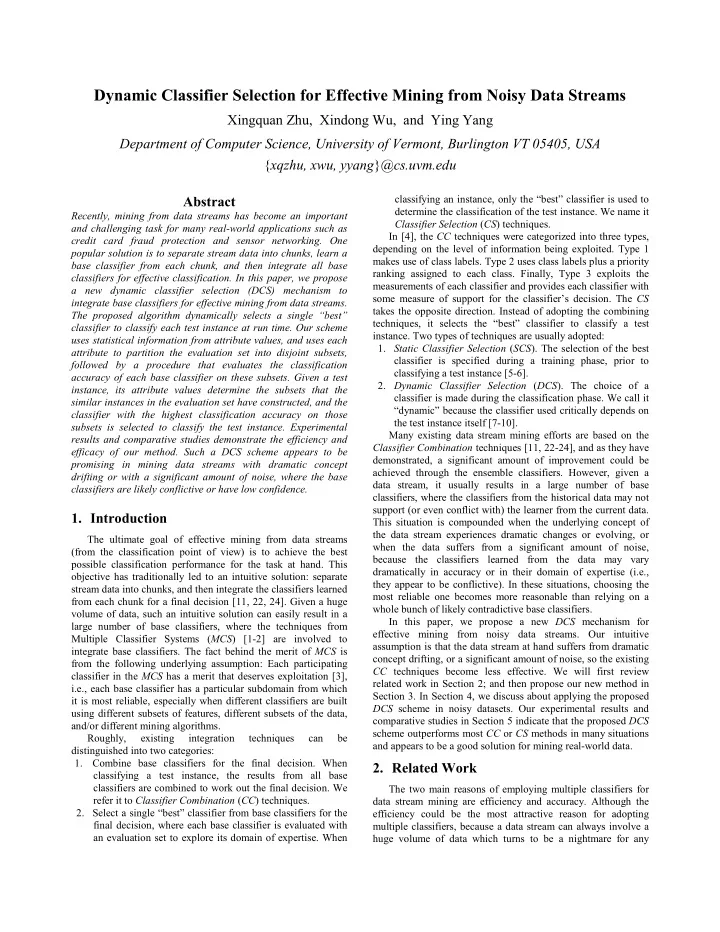

Dynamic Classifier Selection for Effective Mining from Noisy Data Streams Xingquan Zhu, Xindong Wu, and Ying Yang Department of Computer Science, University of Vermont, Burlington VT 05405, USA { xqzhu, xwu, yyang } @cs.uvm.edu Abstract classifying an instance, only the “best” classifier is used to determine the classification of the test instance. We name it Recently, mining from data streams has become an important Classifier Selection ( CS ) techniques. and challenging task for many real-world applications such as In [4], the CC techniques were categorized into three types, credit card fraud protection and sensor networking. One depending on the level of information being exploited. Type 1 popular solution is to separate stream data into chunks, learn a makes use of class labels. Type 2 uses class labels plus a priority base classifier from each chunk, and then integrate all base ranking assigned to each class. Finally, Type 3 exploits the classifiers for effective classification. In this paper, we propose measurements of each classifier and provides each classifier with a new dynamic classifier selection (DCS) mechanism to some measure of support for the classifier’s decision. The CS integrate base classifiers for effective mining from data streams. takes the opposite direction. Instead of adopting the combining The proposed algorithm dynamically selects a single “best” techniques, it selects the “best” classifier to classify a test classifier to classify each test instance at run time. Our scheme instance. Two types of techniques are usually adopted: uses statistical information from attribute values, and uses each 1. Static Classifier Selection ( SCS ). The selection of the best attribute to partition the evaluation set into disjoint subsets, classifier is specified during a training phase, prior to followed by a procedure that evaluates the classification classifying a test instance [5-6]. accuracy of each base classifier on these subsets. Given a test 2. Dynamic Classifier Selection ( DCS ). The choice of a instance, its attribute values determine the subsets that the classifier is made during the classification phase. We call it similar instances in the evaluation set have constructed, and the “dynamic” because the classifier used critically depends on classifier with the highest classification accuracy on those the test instance itself [7-10]. subsets is selected to classify the test instance. Experimental Many existing data stream mining efforts are based on the results and comparative studies demonstrate the efficiency and Classifier Combination techniques [11, 22-24], and as they have efficacy of our method. Such a DCS scheme appears to be demonstrated, a significant amount of improvement could be promising in mining data streams with dramatic concept achieved through the ensemble classifiers. However, given a drifting or with a significant amount of noise, where the base data stream, it usually results in a large number of base classifiers are likely conflictive or have low confidence. classifiers, where the classifiers from the historical data may not support (or even conflict with) the learner from the current data. 1. Introduction This situation is compounded when the underlying concept of the data stream experiences dramatic changes or evolving, or The ultimate goal of effective mining from data streams when the data suffers from a significant amount of noise, (from the classification point of view) is to achieve the best because the classifiers learned from the data may vary possible classification performance for the task at hand. This dramatically in accuracy or in their domain of expertise (i.e., objective has traditionally led to an intuitive solution: separate they appear to be conflictive). In these situations, choosing the stream data into chunks, and then integrate the classifiers learned most reliable one becomes more reasonable than relying on a from each chunk for a final decision [11, 22, 24]. Given a huge whole bunch of likely contradictive base classifiers. volume of data, such an intuitive solution can easily result in a In this paper, we propose a new DCS mechanism for large number of base classifiers, where the techniques from effective mining from noisy data streams. Our intuitive Multiple Classifier Systems ( MCS ) [1-2] are involved to assumption is that the data stream at hand suffers from dramatic integrate base classifiers. The fact behind the merit of MCS is concept drifting, or a significant amount of noise, so the existing from the following underlying assumption: Each participating CC techniques become less effective. We will first review classifier in the MCS has a merit that deserves exploitation [3], related work in Section 2; and then propose our new method in i.e., each base classifier has a particular subdomain from which Section 3. In Section 4, we discuss about applying the proposed it is most reliable, especially when different classifiers are built DCS scheme in noisy datasets. Our experimental results and using different subsets of features, different subsets of the data, comparative studies in Section 5 indicate that the proposed DCS and/or different mining algorithms. scheme outperforms most CC or CS methods in many situations Roughly, existing integration techniques can be and appears to be a good solution for mining real-world data. distinguished into two categories: 1. Combine base classifiers for the final decision. When 2. Related Work classifying a test instance, the results from all base classifiers are combined to work out the final decision. We The two main reasons of employing multiple classifiers for refer it to Classifier Combination ( CC ) techniques. data stream mining are efficiency and accuracy. Although the 2. Select a single “best” classifier from base classifiers for the efficiency could be the most attractive reason for adopting final decision, where each base classifier is evaluated with multiple classifiers, because a data stream can always involve a an evaluation set to explore its domain of expertise. When huge volume of data which turns to be a nightmare for any
Recommend
More recommend